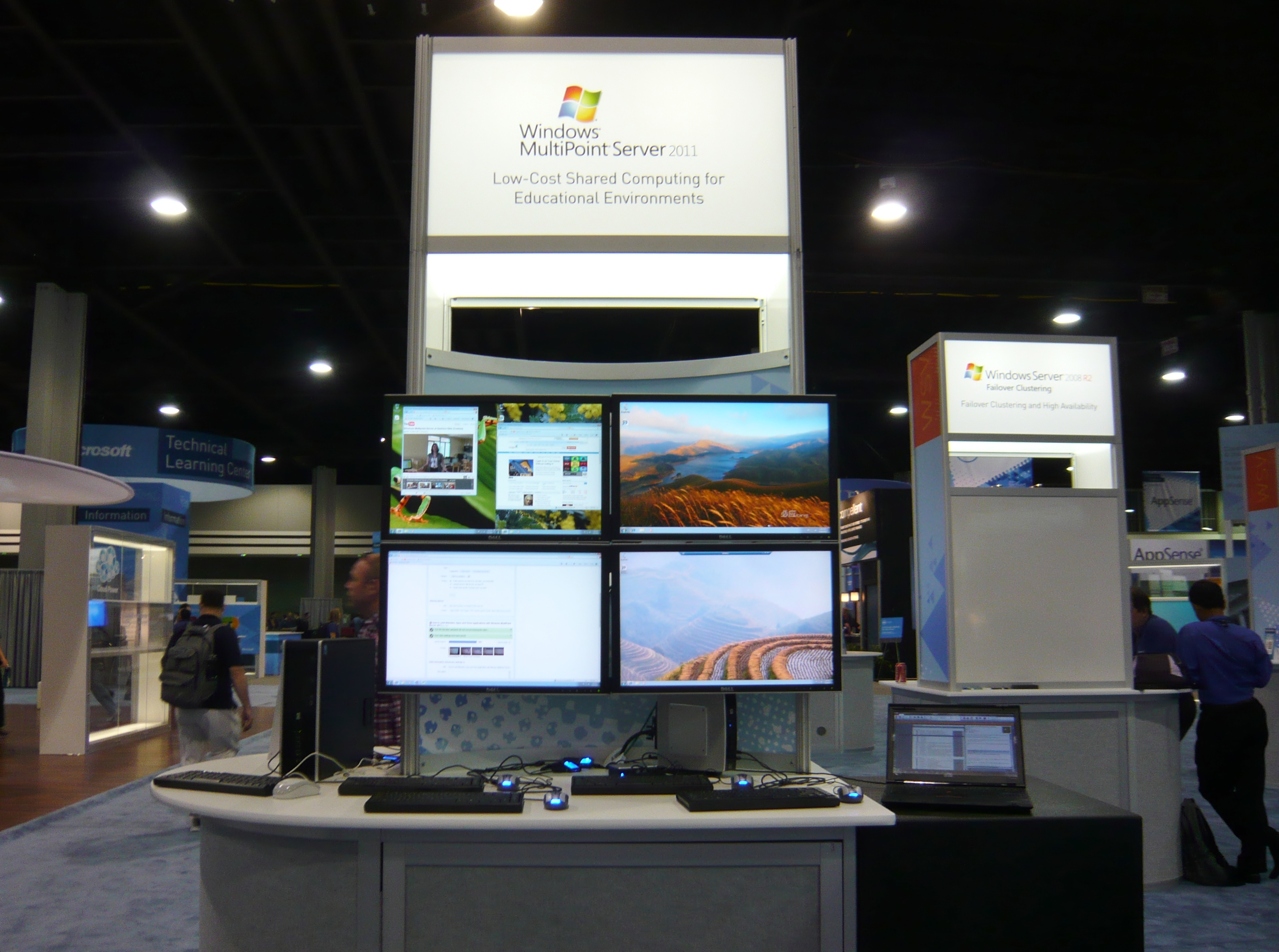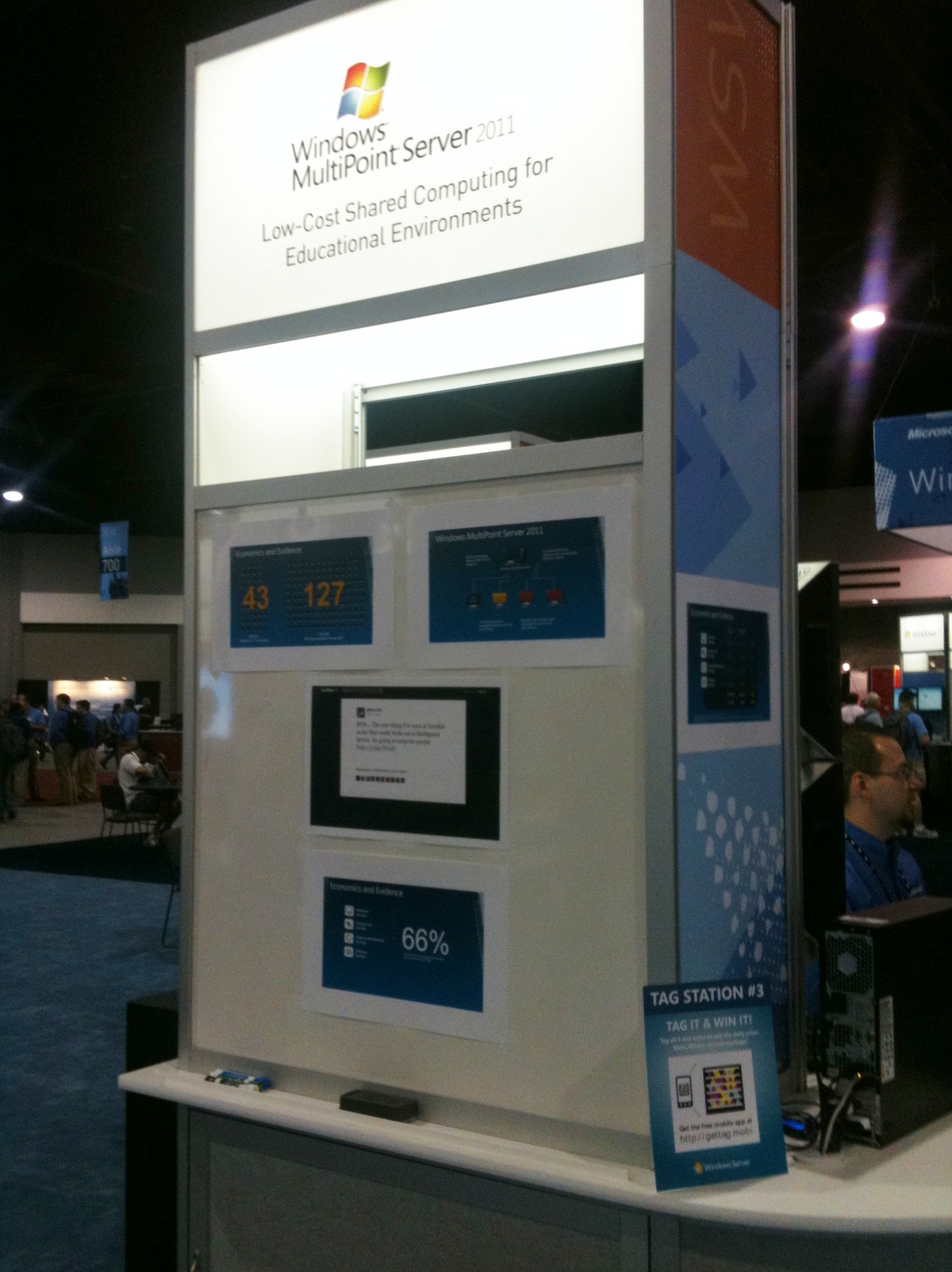Windows MultiPoint Server 2011 - Common Questions and Answers Part 2 (from TechEd)
First and foremost, thanks to everyone that visited us at the TechEd booth. We had amazing energy at the booth, and it was great to talk with everyone.
For those that couldn't join us in person, we filmed 12 instructional videos from the show floor and here's a couple pictures (click to expand).
However, the most interesting part of the show for me was the Q&A at the booth, and at the general session (reviewable online here).
Here are the most common questions and answers from the show:
Q: Is this just Remote Desktop Session Host (RDSH - formerly Terminal Server)? How is this different than RDSH?
A: Windows MultiPoint Server 2011 (WMS) is quite similar to RDSH; and in fact it is built upon the same robust RDS platform, so it supports traditional RDP thin clients as stations. The easiest way to think about it is as a “turn-key” RDSH server with some extra enhancements, the primary differences being support for cheaper "local" thin clients than traditional RDSH can support and also an easy to use focused desktop management experience
Q: What are "local" stations?
A: In addition to conventional LAN-based RDP clients, Windows MultiPoint Server also supports the ability to create multiple "local" stations. Local stations are those where all the hardware plugs directly into the box itself. Here's an example: with traditional Windows, if you plug in multiple keyboards, monitors and mice, they are all available to a single user. With Windows MultiPoint Server, multiple keyboards monitors and mice can be turned into multiple independent stations. Does your PC have three monitor ports on the back? With MultiPoint, you can plug in three monitors, plus three keyboards and mice via usb hubs, and magically you get three stations.
Q: Is this just VDI? How does this compare to VDI? Why would choose one vs. the other?
A: WMS is similar in concept to VDI, however it can deliver the same capabilities at a cheaper cost and significantly reduced complexity than VDI. With VDI, each user gets his or her own virtual machine. With MultiPoint, one machine is shared across many users. MultiPoint is the better in situations where cost and lack of IT professional skills warrant an easy to use, configure and manage desktop solution. VDI could be the solution to use in large scale desktop deployments with dedicated IT staff.
Q: How many stations can I connect to a MultiPoint Server?
A: MultiPoint Server is offered in two editions, each with different station limits. WMS 2011 Standard can support up to 10 stations and WMS 2011 Premium can support up to 20 stations.
Q: Why did you limit the number of stations to 20? RDSH doesn’t have that limit.
A: WMS 2011 works a little differently under the covers to support the different types of low cost thin clients that it can use than RDSH. Because of this technology, the scale per server is limited much lower than a typical RDSH deployment.
Q: I need more than 20 stations. What do I do?
A: Windows MultiPoint Server has a feature known as multi-server management, meaning that despite a 20 station per server limit, you can collectively manage as many servers as needed to scale to your classroom, lab, or other environment size. The typical deployment for MultiPoint is not to build large enterprise style traditional RDS servers that scale to 100's seats or more per host. Rather, you can use less expensive hardware, target a smaller number of seats per host, and string together multiple machines to manage as one.
Q: What type of hardware do I need to scale this box?
A: This depends heavily on the size of the deployment. Microsoft provides a table that guides customers in hardware purchasing decisions for Windows MultiPoint Server 2011. This is available in the Windows MultiPoint Server Planning Guide and also replicated in this blog post.
Q: Can I get this product through my MSDN or TechNet subscription?
A: Yes. Windows MultiPoint Server 2011 is available through both TechNet and MSDN channels.
Q: Is this product restricted to just education? Can I use it as an RDS-alternative in other scenarios such as training or labs in internet cafes or small businesses?
A: MultiPoint is available to all customers, segments and environments. While WMS 2011 is focused predominantly towards the academic environment with features such as classroom orchestration, it is also able to be licensed through non-academic channels such as OEM and Volume Licensing. In some situations, MultiPoint could be an appropriate choice for small business deployments as an alternative to Windows Server Remote Desktop Services where customers do not require Windows 7 features such as mobility.
Q: How much does MultiPoint cost/ how do I license it?
A: MultiPoint is priced through several channels including OEM and Volume Licensing with options in both channels for Academic and non-Academic use.
- For OEM pricing please contact your preferred hardware supplier. See the ‘partners’ tab of our website for a list of OEM partners.
- For accurate Volume Licensing pricing please contact your account reseller or refer to the ‘how to buy’ tab of our website.
Q: I already have an existing CASA/EES agreement. Is MultiPoint already part of that?
A: MultiPoint can be easily added on to an existing Campus and School Agreement (CASA) and we are considering its inclusion into a new agreement called EES.
Q: I already have licenses for as many Windows boxes as I want. Do I need to re-buy WMS licenses? Why?
A: MultiPoint is a different type of server license and is not covered by existing Windows 7 purchases. You will need to purchase these server licenses separately to your existing infrastructure.
Q: If I already have existing TS/RDS CALs for my organization, do I need to buy WMS CALs?
A: Yes. WMS 2011 CALs are different to TS/RDS CALs. Please contact your OEM or Account Reseller for more information on appropriate licensing or refer to the ‘how to buy’ tab of our website.
Q: Does MultiPoint integrate into an Active Directory environment?
A: WMS 2011 Premium can join an Active Directory domain and also participate in Group Policy and other domain functions. WMS 2011 Standard cannot be a part of an Active Directory domain.
Q: This is running Windows 7, right?
A: No. While WMS 2011 provides a “Windows 7 like” desktop experience, it’s not running Windows 7 or a VDI derivative. It is based on the robust Windows Server 2008 R2 platform and utilizes a portion of the Remote Desktop Services Session Host platform. The underlying shell of the operating system has been tweaked and optimized to make it appear as much like a Windows 7 interface as possible. Under the covers, it is Windows Server 2008 R2.
Q: Can I virtualize MultiPoint?
A: Yes you can. We fully support the WMS 2011 Premium edition in a virtualized deployment. However, this style of deployment is normally limited to LAN based conventional thin clients due to the lack of full USB or Direct Connect support within a VM.
Q: What type of LAN based thin clients can I use? Windows7 Embedded? XP Embedded? CE? Linux? RemoteFX?
A: WMS 2011 supports a very broad range of LAN based thin client solutions, just as does Windows Server 2008 R2. All are supported provided that they are using Remote Desktop Protocol (RDP) 5 or higher to connect. The best experience will be found when running RemoteFX based thin clients due to the improvements in RDP for this new capability.
Q: Can the teacher/admin administer the box remotely?
A: Yes. The teacher or admin can remotely connect (through RDP or RemoteApp) to the MultiPoint Server to run MultiPoint Manager and administer all WMS 2011 servers centrally from the one console. The MultiPoint Manager console has a task that will easily create the connection file that publishes either the entire server desktop or just the MultiPoint Manager console.
Q: I am a partner. Can I resell this software?
A: To sell Windows MultiPoint Server 2011 you must be:
- Authorized to preinstall WMS 2011 under the appropriate OEM agreement to sell directly
- Have a reseller relationship with an OEM that can preinstall WMS 2011
- Be an Academic or Volume Licensing reseller with access to Open licensing programs
Q: Can you support multi-mon with this software?
A: Yes, however only the LAN-based thin clients can offer this option. USB or Direct Connect stations are single monitor only.

